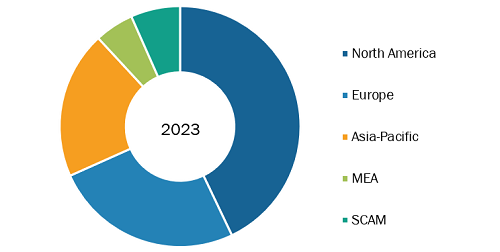Topical Drugs Type to Hold Largest Hypopigmentation Disorder Treatment Market Share During 2023–2031
According to our new research study on "Hypopigmentation Disorder Treatment Market Size and Forecast (2021–2031), Global and Regional Share, Trend, and Growth Opportunity Analysis," the market value is projected to grow from US$ 4.4 billion in 2023 to US$ 6.7 billion by 2031; the market is anticipated to record a CAGR of 5.41% from 2023 to 2031.
Hypopigmentation might occur in people of all races, but it may be more noticeable as white patches or uneven skin color in people with darker skin tones. Hypopigmentation disorders usually arise as a result of damage or trauma to the skin. Burns, blisters, and infections all can cause damage to the skin and cause hypopigmentation. Treatment such as chemical or laser peels, when performed incorrectly, can also induce hypopigmentation. Globally, vitiligo is one of the most common etiologies associated with acquired hypopigmented conditions. According to an article published in JAMA Dermatology in 2021, the global vitiligo prevalence varies from 0.004% to 2.28%. The disease has a profound effect on patients’ well-being and is associated with autoimmune comorbid conditions. Factors such as increasing hypopigmentary disorders and advent of hypopigmentation therapeutics for their treatment and management. This factor has further raised awareness among patients suffering from hypopigmentation.
Hypopigmentation Disorder Treatment Market, by Region, 2023 (%)
Hypopigmentation Disorder Treatment Market Size and Forecast (2021 - 2031), Global and Regional Share, Trend, and Growth Opportunity Analysis Report Coverage: By Treatment (Topical Drugs, Laser Therapy, Chemical Peels, Microdermabrasion, Phototherapy, and Others), Disease Indication (Pityriasis Alba, Vitiligo, Albinism, Post-Inflammatory Hyperpigmentation, and Others), End User (Aesthetic Clinics, Dermatology Centers, and Hospitals), and Geography
Hypopigmentation Disorder Treatment Market Growth by 2031
Download Free Sample
Source: The Insight Partners Analysis
Treatment methods for hypopigmentation, including topical medications such as calcineurin inhibitors and corticosteroids, have gathered massive attention among dermatology companies developing therapies for hypopigmentation disorders patients. These patients are seeking effective as well as affordable treatment. In terms of cost and effectiveness, the chemical peel treatment holds one end of the hypopigmentation disorder therapy spectrum, whereas microdermabrasion and laser therapy are at the lower end. Moreover, several topical drugs are being used for the management of hypopigmented macules. Thus, topical drugs are contributing significantly to the hypopigmentation disorder treatment market and its value chain.
Topical drugs are prescribed by physicians as the first-line therapy for hypopigmentation. The rising demand for cosmetic procedures to camouflage depigmented areas and improve skin appearance further benefits the hypopigmentation disorder treatment market. Other treatments such as tattooing, micropigmentation, and cosmetic camouflage cream are also gaining popularity among patients to conceal hypopigmented patches. Moreover, with the growing awareness, patients are showing high acceptance for cosmetic procedures. The availability of advanced technologies for precise pigment delivery is further fueling the hypopigmentation disorder treatment market expansion. However, the high cost of treatment and adverse effects associated with treatment hinder the hypopigmentation disorder treatment market growth.
The hypopigmentation disorder treatment market forecast can help stakeholders in this marketplace plan their growth strategies. Allergan, SkinCeuticals, Pierre Fabre Group, Incyte Corporation, Episciences Inc., Phio Pharmaceuticals, Obagi Cosmeceuticals LLC, Alvogen, Bella Aurora, and AbbVie are a few key companies operating in the market are a few key companies profiled in the hypopigmentation disorder treatment market report. These companies have been implementing organic (product launches, expansions, and product approvals) and inorganic (partnerships and collaborations) strategies that contribute to their growth and lead to market progress.
The report segments the hypopigmentation disorder treatment market as follows:
The hypopigmentation disorder treatment market analysis has been carried out by considering the following segments: treatment, disease indication, and end user. By treatment, the market is classified into basic topical drugs, laser therapy, chemical peels, microdermabrasion, phototherapy, and others. Based on disease indication, the market is segmented into pityriasis alba, vitiligo, albinism, and post-inflammatory hypopigmentation. Based on end user, the market is classified into aesthetics clinics, dermatology centers and hospitals. In terms of end user, the market is segmented into hospitals, clinics, and ambulatory surgical centers. The geographic scope of the hypopigmentation disorder treatment market report includes North America (US, Canada, and Mexico), Europe (UK, Germany, France, Italy, Spain, and Rest of Europe), Asia Pacific (China, Japan, India, Australia, South Korea, and Rest of Asia Pacific), the Middle East & Africa (UAE, Saudi Arabia, South Africa, and Rest of Middle East & Africa), and South & Central America (Brazil, Argentina, and Rest of South & Central America). In 2022, North America held the largest hypopigmentation disorder treatment market share. The market in North America is subsegmented into the US, Canada, and Mexico. The rising prevalence of hypopigmentation disorder conditions such as vitiligo, pityriasis alba, and albinism propels the market in the US. According to the study published in JAMA Dermatology in 2022, the prevalence of vitiligo among the US adult population (diagnosed and undiagnosed combined) was estimated at 0.76–1.11% (i.e., 1.9–2.8 million cases) in 2020. Moreover, pharmaceutical companies and research institutions are actively involved in introducing novel oral medications, topical creams, phototherapy products, and surgical interventions, among others, to address the unmet needs of patients suffering from hypopigmentation disorders. Collaborations between academia and industry players are complementing the process of discovery of new therapeutic targets. In addition, the increasing occurrence of these disorders among the aging population and an upsurge in the number of clinical trials focused on their treatments drive the hypopigmentation disorder treatment market growth in the US.
Contact Us
Phone: +1-646-491-9876
Email Id: sales@theinsightpartners.com